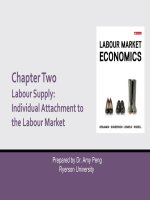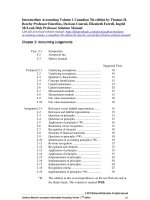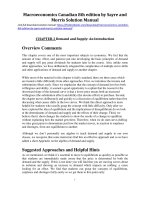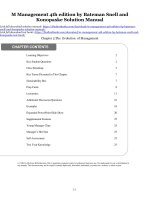Labour market economics canadian 8th edition by benjamin gunderson lemieux riddell solution manual
Bạn đang xem bản rút gọn của tài liệu. Xem và tải ngay bản đầy đủ của tài liệu tại đây (2.9 MB, 69 trang )
Prepared by Dr. Amy Peng
Ryerson University
Define the key elements of labour force measurement employment, unemployment, labour force participation,
and hours worked - and explain how they are measured
and reported by Statistics Canada.
2. Illustrate graphically how the income-leisure model
reflects the trade-offs that consumers face in deciding
whether and how much to work.
3. Distinguish theoretically between the work choices made
by individuals and the economic opportunities that they
choose from.
1.
© 2017 McGraw-Hill Education Ltd.
2-2
Explain using diagrams how an increase in the wage rate
leads to offsetting income and substitution effects, and
how this yields an ambiguous effect of wage changes on
labour supply.
5. Interpret the economic and other factors affecting a
married woman’s decision to work, and show how this
decision can be captured within the income-leisure
(labour supply) model.
4.
© 2017 McGraw-Hill Education Ltd.
2-3
The Theory of Labour Supply
Labour Force (LF)
Individuals in the eligible population (15 years
and older) who participate in labour market
activities, either employed or unemployed
Labour Force Participation Rate (LFPR)
The fraction of the eligible population that
participates in the labour force
LFPR = LF/POP
© 2017 McGraw-Hill Education Ltd.
2-5
To be considered unemployed, a person must
be in one of the following three categories:
1. Without work but has made specific efforts to find
a job within the previous four weeks
2. Waiting to be called back to a job from which he or
she has been laid off
3. Waiting to start a new job within four weeks
© 2017 McGraw-Hill Education Ltd.
2-6
© 2017 McGraw-Hill Education Ltd.
2-7
© 2017 McGraw-Hill Education Ltd.
2-8
© 2017 McGraw-Hill Education Ltd.
2-9
© 2017 McGraw-Hill Education Ltd.
2-10
© 2017 McGraw-Hill Education Ltd.
2-11
© 2017 McGraw-Hill Education Ltd.
2-12
Hours-of-work
Hours per day, days per week, weeks per year
It may affect the quantity and the quality of
labour supply
© 2017 McGraw-Hill Education Ltd.
2-13
© 2017 McGraw-Hill Education Ltd.
2-14
The choice of hours worked given
opportunities and value of non-market
time
Preferences and Constraints
Individuals choose the feasible outcomes
which yield the highest level of satisfaction
© 2017 McGraw-Hill Education Ltd.
2-15
Two “goods”
Consumption
Leisure
Represented by indifference curves
(A person is indifferent between various combinations
of consumption and leisure on an indifference curve)
© 2017 McGraw-Hill Education Ltd.
2-16
Consumption
A - willing to give up abundance
of consumption for leisure
A
B
0
© 2017 McGraw-Hill Education Ltd.
B - willing to give up
abundance of leisure for
consumption
Leisure (time)
(non-market activity)
17
Consumption
(goods and services)
C11
C12
A
C0
U02
U01
0
© 2017 McGraw-Hill Education Ltd.
l1
l0
Leisure (time)
(non-market activity)
18
Preferences over all conceivable
combinations of consumption and leisure
All combinations lie on some indifference
curve
Represented by an indifference map
© 2017 McGraw-Hill Education Ltd.
2-19
Consumption
U2
U1
U0
Leisure (time)
(non-market activity)
© 2017 McGraw-Hill Education Ltd.
2-20
Constrained are determined by the economic
properties of the market, which, in turn,
transform consumption-leisure to incomeleisure by setting the price of consumption.
© 2017 McGraw-Hill Education Ltd.
2-21
(a) Simple Full-time/Part-time Choice
© 2017 McGraw-Hill Education Ltd.
2-22
(b) Typical Linear Potential Income Constraint
© 2017 McGraw-Hill Education Ltd.
2-23
(c) Nonliner Potential Income Constraint
© 2017 McGraw-Hill Education Ltd.
2-24
Optimal amount of income and leisure
Utility-maximizing equilibrium
Highest indifference curve given the income constraint
Compare MRS with the Market Wage Rate
MRS: measures the willingness to exchange leisure for
consumption (or income)
Market Wage Rate: measures the ability to exchange
leisure for income
© 2017 McGraw-Hill Education Ltd.
2-25









